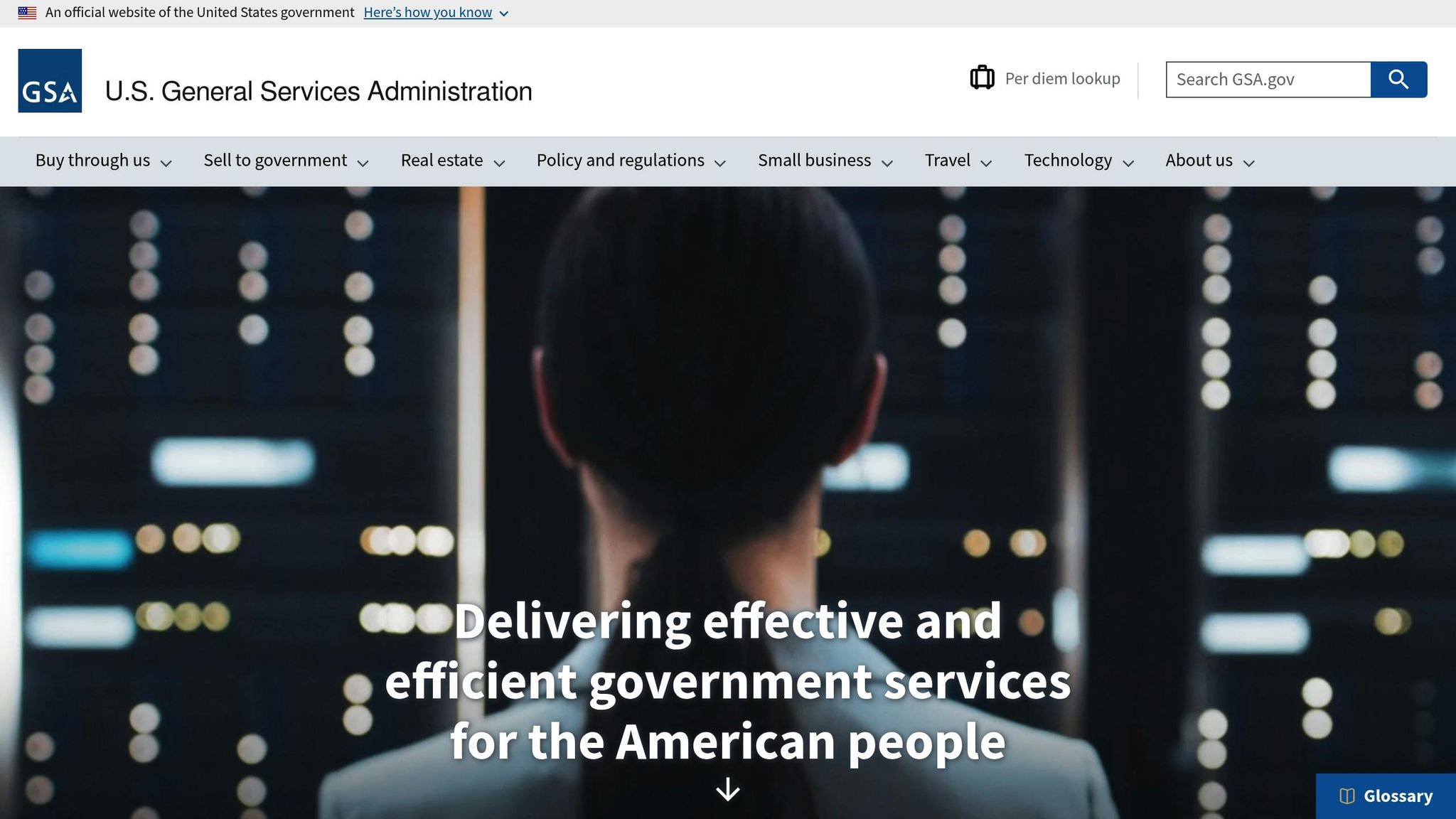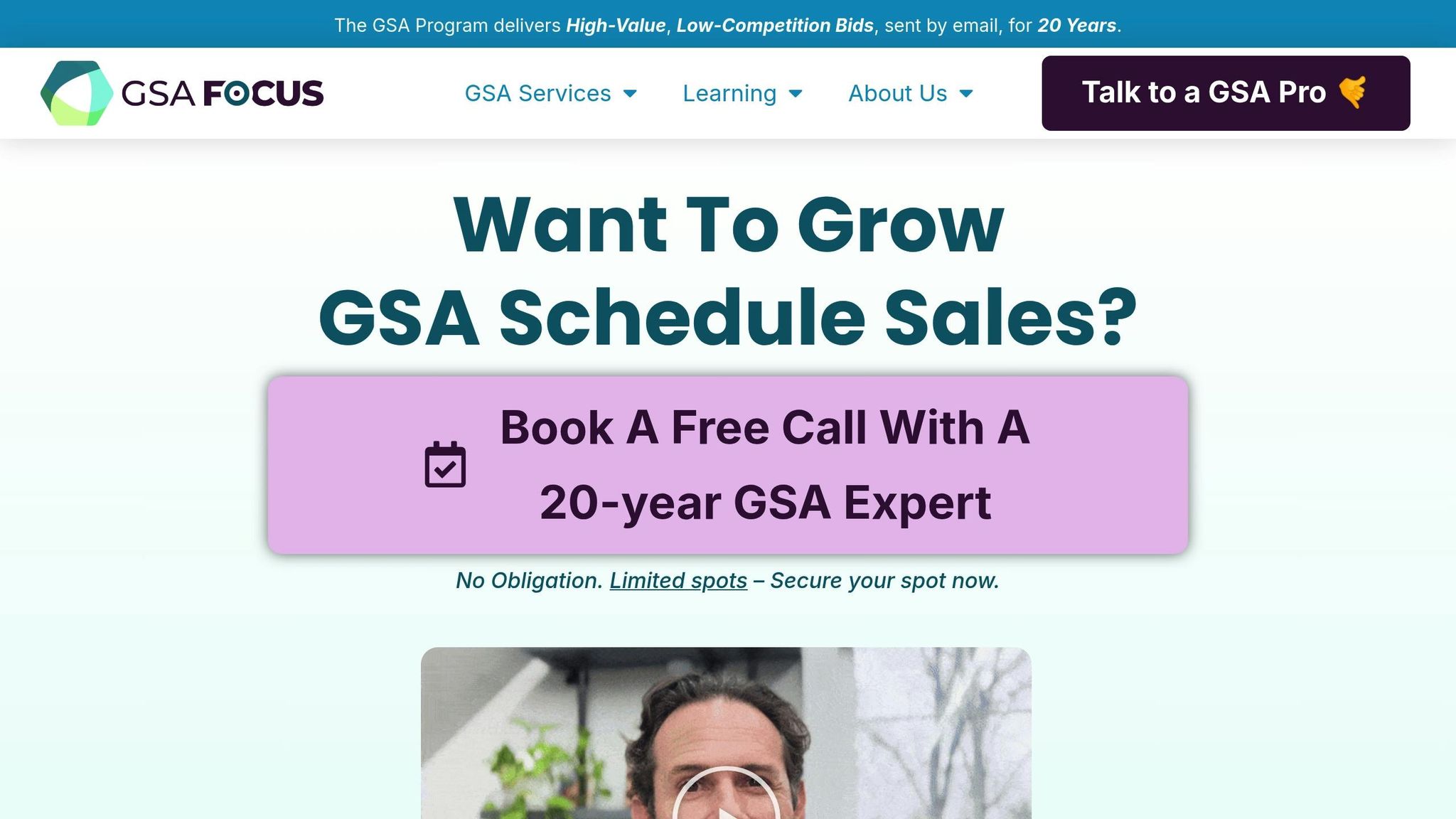Avoiding mistakes in GSA bidding is critical for securing federal contracts. Errors can lead to rejections, wasted time, and lost revenue. Here’s a quick breakdown of the most common pitfalls and how to steer clear of them:
- Wrong SIN Selection: Misaligned Special Item Numbers (SINs) prevent you from accessing relevant opportunities.
- Incomplete Documentation: Missing or outdated paperwork often results in disqualification.
- Compliance Failures: Violating rules like the Trade Agreements Act (TAA) can cost you contracts.
- Poor Pricing Strategy: Overpricing or underpricing can hurt your chances and profitability.
- Skipping Professional Help: Tackling the process alone increases the risk of errors and delays.
These mistakes are preventable with thorough preparation, accurate documentation, and expert guidance. Let’s dive into the details to help you navigate the GSA process effectively.
10 Deadly Proposal Mistakes That Kill Government Contract Wins
Mistake #1: Wrong Special Item Number (SIN) Selection
Picking the wrong Special Item Number (SIN) can derail your GSA proposal faster than you think. It’s one of the most common reasons proposals get rejected, and it can seriously hinder your federal contracting efforts.
What Are SINs and Why They Matter
"The Special Item Number (SIN) is a numerical identifier that classifies the products and services offered by GSA contract holders to government buyers." – GSA Schedules Services
Think of SINs as the backbone of the GSA marketplace. The GSA MAS Program organizes its offerings into 12 broad categories, which are further divided into subcategories and ultimately broken down into 315 specific SINs. These identifiers aren’t just bureaucratic codes – they’re essential tools that help federal buyers find exactly what they need. SINs also align closely with NAICS codes, simplifying the procurement process.
Here’s the catch: if your product or service isn’t tied to a SIN on your contract, you won’t even see relevant opportunities. That’s why it’s critical to understand SIN scopes and avoid common selection mistakes.
Common SIN Selection Errors
One of the most frequent mistakes is choosing a SIN that doesn’t fully align with your offerings. For example, in July 2021, Winvale shared how a company selling pens correctly aligned with Large Category A (Office Management) under the Office Supplies subcategory, using SIN 339940 for "Desk Supplies". This proper alignment ensured their proposal fit GSA’s criteria.
Another common pitfall is failing to distinguish between service categories. GSA requires that your past performance directly supports the services you propose. Misaligned scopes often result in rejected proposals, forcing companies to go back and resubmit.
Additionally, many businesses skim SIN titles without reading the detailed descriptions. This oversight can lead to misclassification, which is a fast track to proposal rejection.
How to Choose the Right SIN
So, how do you avoid these mistakes? Start by asking yourself: Does my offering truly match the scope of this SIN? The best place to begin is the GSA eLibrary, where you’ll find detailed descriptions and scope requirements for each SIN. Don’t just glance at the title – dig into the full description.
Next, consult the MAS Modification Guide and check category-specific attachments on SAM.gov. These resources outline the documentation you’ll need. For example, service-based SINs typically require past performance examples, while product-based SINs might demand technical certifications or compliance documentation.
As you prepare your paperwork, double-check that everything is accurate and up to date. For services, include strong examples of past performance. For products, ensure you have all necessary certifications and compliance documents. GSA won’t hesitate to reject a proposal if it doesn’t meet scope requirements.
If you’re unsure, consider working with GSA experts who can review your SIN selection before submission. Their insights can help you avoid costly delays and resubmissions.
Getting your SIN right isn’t just about avoiding rejection – it’s about positioning yourself to receive notifications for RFQs and RFPs that match your business. Nail this step, and you’ll be set up to compete for the opportunities that matter most to you.
Mistake #2: Incomplete Proposal Documentation
One of the quickest ways to have your GSA proposal rejected is through documentation errors. The GSA meticulously pre-screens all proposals for accuracy and completeness, and missing or incorrect paperwork often leads to immediate disqualification.
Common Documentation Errors
Here are some frequent documentation mistakes that can jeopardize your proposal:
- Incorrect registration in SAM.gov: Ensure that the information in your SAM.gov registration is consistent across all submissions.
- Inconsistent pricing across documents: If the pricing in your eOffer doesn’t match your capability statements or financial records, it raises serious concerns during the evaluation process.
- Using outdated forms and templates: GSA frequently updates its forms, and using an older version can lead to automatic rejection. Always download the latest templates directly from SAM.gov.
- Financial documentation issues: Missing financial records or incomplete justifications can significantly delay the evaluation process.
These common errors create unnecessary hurdles, causing delays or rejections that could have been easily avoided.
What Happens When Proposals Are Incomplete
Submitting an incomplete proposal doesn’t just slow things down – it can completely derail your efforts. If your submission is rejected, you’ll need to start over, which extends the time it takes to secure a contract. Worse, it could mean missing out on valuable opportunities. For example, one company lost a contract because they failed to disclose critical discount details. In another case, a construction services firm had its GSA Schedule contract terminated due to inadequate pricing documentation over time.
How to Prepare Complete Proposals
To steer clear of these issues, adopt these practices:
- Review solicitation requirements thoroughly and verify consistency: Use the Offer Submission Checklist and double-check that your business name, address, and DUNS number match across SAM.gov, eOffer, and your capability statements.
- Keep pricing consistent across all documents: Ensure that every document tells the same story when it comes to pricing.
- Conduct a meticulous internal review: Have team members carefully examine all forms and documents for errors. If your team lacks GSA experience, consider hiring an accountant to review your financial documentation.
- Always use updated templates from SAM.gov: Never rely on saved versions from prior submissions. Download fresh templates for each new submission to meet the latest requirements.
- Submit accurate and complete proposals: Every detail matters. Incomplete or inaccurate submissions lead to delays and missed opportunities.
Mistake #3: Failing to Meet Compliance Requirements
Federal compliance requirements aren’t just bureaucratic hurdles – they’re the backbone of maintaining your GSA contract and your business’s eligibility for government opportunities. With the U.S. government allocating over $45 billion annually through the GSA Multiple Award Schedule (MAS) program, staying compliant ensures you can tap into this lucrative market. Let’s break down the essentials to help you steer clear of common pitfalls.
Key Compliance Requirements You Need to Know
Compliance starts with the Trade Agreements Act (TAA). Every product listed under your GSA Schedule must be manufactured in TAA-compliant countries. This includes nations like the United States, Canada, Mexico, EU member states, Japan, South Korea, Israel, and Australia. However, products from countries like China, Russia, India, and Malaysia do not qualify.
Beyond product compliance, sales benchmarks are critical. You must generate at least $100,000 in sales during the first 60 months of your contract and $125,000 in every subsequent 60-month period to avoid cancellation. Additionally, contractors are required to:
- Pay a 0.75% Industrial Funding Fee (IFF) on all sales.
- Submit accurate monthly Transactional Data Reporting (TDR).
- Keep your SAM registration up to date.
- For service contracts, follow established labor standards.
Most Common Compliance Pitfalls
"As a contract holder, it’s your responsibility to remain compliant, and it can be overwhelming to keep track of especially if you are a new contract holder or don’t have someone on your team who is familiar with GSA Schedule maintenance." – Lillian Bohan, Consultant
Some of the most frequent mistakes include offering non-compliant products, often due to failing to verify TAA compliance or mislabeling the country of origin. Errors in TDR reporting – whether it’s missing deadlines, incomplete data, or incorrect reporting frequency – are also common.
Other issues that can put your contract at risk include:
- Delivery delays caused by not prioritizing government orders or failing to update the Purchase Order (PO) portal.
- Selling unauthorized products, such as those lacking manufacturer approval or a required Letter of Supply.
- Late or miscalculated IFF payments.
- Misleading representations, where there’s a gap between what’s promised and what’s delivered.
Tips to Stay Compliant
To stay on top of compliance, consider these proactive strategies:
- Automate reminders for key deadlines, such as monthly TDR submissions, quarterly pricing reviews, and annual audits.
- Conduct monthly internal reviews to catch and resolve issues early.
- Keep detailed records of all GSA-related activities, including sales data, fee payments, product certifications, and communications with GSA officials.
- Stay informed on regulatory changes by attending GSA training sessions and consulting with compliance experts when needed.
- For resellers, perform due diligence to verify supplier compliance and regularly monitor their TAA status.
"Contract compliance should always be a priority for Multiple Award Schedule (MAS) contractors, but it’s now more important than ever." – Lucy Hoak, Proposal Writer, Winvale
Additionally, assign clear responsibilities within your team to ensure proper GSA contract management. Remember, compliance isn’t a one-time task – it’s an ongoing process that requires consistent attention throughout the lifespan of your contract, which can extend up to 20 years.
sbb-itb-8737801
Mistake #4: Poor Pricing Strategy
After ensuring compliance and proper documentation, the next key element in securing a GSA contract is your pricing strategy. A misstep here can derail even the strongest bid.
Why Wrong Pricing Hurts Your Bids
Pricing isn’t just about numbers – it’s a make-or-break factor for your bid. If you overprice, it can suggest you don’t fully understand the project’s scope, making your offer less appealing. On the flip side, underpricing might win you the contract, but it often leads to unprofitable projects, strained resources, and a damaged reputation. Federal buyers are looking for pricing that reflects fair market value, balancing quality outcomes with sustainable operations.
How to Price Your GSA Bids Right

The foundation of a strong pricing strategy lies in detailed market research. The GSA requires that your government rates match or beat the rates offered to your top commercial clients. Start by using the GSA CALC tool to benchmark your rates against existing contracts. Refine your search with filters like location and experience to get precise comparisons.
For reliable insights, leverage averages from over 150 contracts. Cross-check your findings with resources like the GSA eLibrary, GSA Advantage, and FPDS to ensure accuracy. Keep in mind that GSA pricing is based on fully burdened ceiling rates, which include both direct and indirect costs. Use these ceiling rates as a guide, tailoring your rates to align with the specific scope, complexity, and scale of each project.
To stand out, focus on value-based pricing. Highlight measurable benefits through case studies or testimonials that underscore your value proposition. Consider adding Economic Price Adjustment (EPA) clauses to account for inflation and market fluctuations over the contract’s term. Be sure to factor in all compliance-related costs when structuring your pricing. Regularly monitor performance to refine your pricing approach for renewals or extensions.
Additionally, offering volume-based discounts and providing strong performance justifications can strengthen your proposal and demonstrate its commercial appeal.
Mistake #5: Not Getting Professional Help
Many businesses attempt to tackle the GSA Schedule process on their own, often leading to rejected applications, compliance headaches, and missed revenue opportunities.
Why Professional Help Matters
The GSA Schedule process is no walk in the park. It’s filled with intricate requirements, specialized terminology, and strict compliance rules that can overwhelm even the most capable in-house teams. In fact, companies managing their GSA schedules internally are 35% more likely to face compliance issues compared to those who partner with external consultants. These missteps can result in suspended or canceled contracts, costing businesses an average of 15% in lost revenue.
Time is another major hurdle. From preparing documents and verifying compliance to negotiating pricing, the process demands a significant investment of effort – something many business owners simply don’t have to spare. This is where professional help becomes not just useful but essential.
Experts can make all the difference. They excel at selecting the right SINs (Special Item Numbers), crafting effective pricing strategies, and ensuring all documentation meets GSA’s rigorous standards. Professionals also handle tricky areas like eMod and Mass Mod processes for contract modifications, keep eCatalogs updated, and manage renewals seamlessly.
How GSA Focus Can Simplify the Process

GSA Focus offers a full-service solution tailored specifically for small businesses. They boast a 98% success rate in securing GSA contracts and deliver an average ROI of 87x. Even more impressively, they claim to be 4-6 times faster than businesses attempting the process on their own.
"We take all the ‘brain power’ out of getting an immensely profitable GSA contract. On average, you’ll only need 3 hours to give us what you need. And then… We do the other 100+ hours of work!"
Their approach is straightforward but thorough. GSA Focus manages everything from document preparation and compliance checks (including adherence to Trade Agreements Act regulations) to negotiation support for securing favorable pricing terms. This hands-on guidance minimizes errors and aligns with the broader strategy of avoiding costly GSA bidding mistakes. Remarkably, 57% of their clients had no prior experience working with the GSA, yet they still achieved successful outcomes.
Their expertise shines during pricing negotiations:
"We’re your ‘dedicated negotiators’ for GSA… We’ll make sure you get fair, lucrative and reasonable prices."
The financial upside is hard to ignore. GSA Focus estimates that clients can add as much as $927,000 to their bottom line through successful GSA contracts. Considering that professional consulting services typically cost between $5,000 and $25,000 annually, the potential return on investment is compelling.
But GSA Focus doesn’t stop at contract acquisition. They offer ongoing support for schedule maintenance, marketing efforts, and compliance management. Their commitment is backed by a refund guarantee and a free consultation to assess GSA eligibility. This makes professional guidance not just a smart move but an essential step in avoiding costly mistakes and unlocking government contracting success.
Conclusion: How to Avoid These GSA Bidding Mistakes
Navigating the GSA Schedule process requires careful planning, accuracy, and a deep understanding of federal contracting. With the federal government spending over $649 billion on contracts in fiscal year 2023 – and more than $30 billion of that through GSA Schedules annually – it’s clear that the stakes are high.
Here’s the reality: only about 15% of companies get approved on their first attempt. That statistic alone highlights why avoiding common mistakes is so important. Every misstep can delay your entry into this lucrative market.
The best way to sidestep these pitfalls? Preparation. Start with thorough market research to understand how competitors price their offerings. Keep meticulous records that meet GSA’s strict documentation standards. And don’t forget to establish pricing that aligns with the Most Favored Customer concept.
It’s also crucial to follow solicitation guidelines to the letter. This includes adhering to Trade Agreements Act requirements and meeting labor qualifications. Tools like compliance calendars and periodic audits can help you catch potential issues before they snowball into costly problems.
The numbers don’t lie: while nearly half of GSA Schedule holders are small businesses, over 60% of them fail to generate any revenue from their contracts. This stark contrast shows how professional guidance can make or break your success. For instance, a mid-sized IT services firm secured its GSA Schedule in just six months and boosted revenue by 30% in the first year with expert help. Meanwhile, a small manufacturing company faced rejection and year-long delays due to avoidable mistakes.
Investing in professional assistance can save you time, money, and headaches. Compliance isn’t optional in federal contracting – the penalties, disqualifications, and damage to your reputation often cost far more than doing it right the first time.
To set yourself up for success, take advantage of resources like the GSA eLibrary and Vendor Support Center. Conduct thorough internal reviews of your documentation, and when needed, seek expert advice. The federal contracting market is full of opportunities for those who approach it with diligence, strict compliance, and a well-thought-out strategy.
If the process feels overwhelming, professional intervention can be a game-changer. For example, GSA Focus offers a complete, done-for-you solution, handling everything from document preparation to compliance checks and negotiation support. Partnering with seasoned experts allows you to tackle the complexities of GSA contracting with confidence, paving the way to secure valuable federal contracts.
FAQs
How do I choose the right Special Item Number (SIN) for my GSA proposal to avoid rejection?
Choosing the right Special Item Number (SIN) is a critical step in getting your GSA proposal approved. Start by thoroughly evaluating your products or services, focusing on their main features and scope. Once you have a clear understanding, head over to the GSA eLibrary to find the SINs that best align with your offerings. Pay close attention to the descriptions and specific requirements listed for each SIN.
It’s essential to select a SIN that truly represents your business’s strengths and fits seamlessly with the scope of your proposal. By investing the effort upfront to match your offerings with the correct SIN, you can minimize the chances of delays or rejections during the review process.
What are the key compliance requirements to keep in mind when submitting a GSA bid?
When you’re preparing to submit a GSA bid, meeting compliance requirements isn’t just a formality – it’s a must if you want to succeed. Here are some key points to keep in mind:
- Follow all contract terms and conditions: This includes sticking to agreed-upon pricing, delivery timelines, and reporting standards.
- Hit the $25,000 sales threshold: Your GSA contract requires you to generate at least $25,000 in sales within the first two years.
- Keep your SAM.gov registration active: Double-check that all your information is accurate and up to date in the system.
- Meet Trade Agreements Act (TAA) requirements: Only offer products and services sourced from approved countries.
- Maintain ethical business practices: Transparency and accountability are non-negotiable when working with federal contracts.
You’ll also need to submit regular performance and sales reports to stay in good standing. Staying on top of these requirements not only helps you avoid headaches but also ensures you get the most out of your GSA Schedule Contract.
Why should businesses consider professional assistance for the GSA Schedule process, and what are the key benefits?
Navigating the GSA Schedule process can feel like an uphill battle, but working with seasoned professionals can make a world of difference. Their expertise not only helps ensure compliance with federal regulations but also reduces the likelihood of errors and simplifies the often overwhelming task of document preparation.
By partnering with experts, businesses can save time, avoid expensive missteps, and boost their chances of successfully landing a GSA Schedule contract. Beyond that, these professionals offer valuable support during negotiations and guide companies through the complexities of federal procurement. This allows businesses to stay focused on what they do best while tapping into lucrative government contracting opportunities.
Related posts
- Common GSA Compliance Mistakes And Fixes
- Common GSA Audit Issues and How to Avoid Them
- Why GSA Bids Fail: Key Issues
- GSA Contracting vs. Federal Bidding: Mistakes to Avoid


